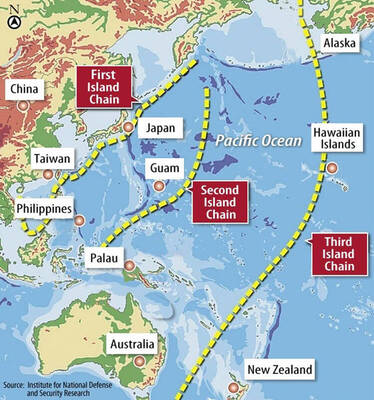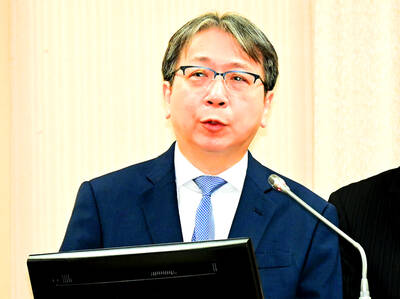Premier Wu Den-yih (吳敦義) yesterday defended the government after a Cabinet document charting the country’s territorial waters made Kinmen and Matsu appear to be parts of China.
“For 10 years Kinmen and Matsu have been deliberately left out [of the country’s official territorial waters] … Over the last 10 years the issue hasn’t been reviewed,” Wu said, referring to a previous version of the map drawn up in 1999.
Asked whether the government had made a secret deal with China on the issue, Wu dismissed the idea.
“There was no secret deal … There must have been some reason why the situation has remained this way for the past 10 years. It hasn’t changed no matter whether the Chinese Nationalist Party [KMT] or the Democratic Progressive Party [DPP] was in power,” Wu said.
Wu also said that Kinmen and Matsu not being included in the document’s boundary line was in line with the consensus on cross-strait relations — “to set aside disputes and create a win-win situation.”
“Kinmen and Matsu belong to Fujian Province … Although Kinmen and Matsu are under the Republic of China’s [ROC] jurisdiction, other parts of Fujian Province are under the jurisdiction of the mainland,” Wu said.
The furor came about after the Chinese-language Liberty Times (the Taipei Times’ sister newspaper) said the Executive Yuan last Wednesday promulgated the revised regulations on the boundaries of the country’s territorial waters following demarcations defined in 1999 that excluded the Diaoyutai (釣魚台) and Paracel (西沙) islands as well as Kinmen and Matsu.
Although the document was promulgated with Wu’s name on it, Wu told reporters yesterday that “I did not know about it until I read about it in [yesterday’s] newspapers.”
The notice shows the ROC’s territorial waters and contiguous areas extend from Taiwan proper and its immediate offshore islands to include the Diaoyutai Islands (釣魚台) in the Pacific Ocean, the Dongsha Islands (or the Pratas Islands, 東沙島) and Chongsha Bank (or Macclesfield Bank, 中沙群島) in the South China Sea.
The scope of the country’s territorial waters remained the same as announced in 1999, the first time the government made the demarcation based on the ROC Territorial Waters and Neighboring Areas Act (中華民國領海及鄰近區法), which was passed a year earlier.
The Ministry of the Interior, which was in charge of drawing up the document, said the purpose of the revisions was merely a technical fine-tuning to adjust to revised nautical charts after the army replaced its original coordination system with the international coordinate system WGS 84.
Executive Yuan Spokesman Su Jun-pin (蘇俊賓) released a press statement saying the government never considered giving up Kinmen and Matsu.
Presidential Office Spokesman Wang Yu-chi (王郁琦) yesterday said that the administration must include Kinmen and Matsu in “the territory of Taiwan” because they are “Taiwan’s legitimate dominion.”
Wang said Minister of the Interior Jiang Yi-huah (江宜樺) told the legislature’s Judiciary and Organic Laws and Statutes Committee yesterday morning that Kinmen and Matsu would be included in the country’s territorial map within a year.
“Our position is that we should consider Kinmen and Matsu as two regions under the legal rule of Taiwan,” he said.
Wang said they did not know why the sea line around the outlying islets of Kinmen and Matsu was not included in the country’s territory when the government first promulgated the charts in 1999, but noted that the former DPP administration did nothing to change it.
Wang said the two islets would be included the next time the map was drawn up.
Wang said that the Presidential Office or the National Security Council had not played any role in the matter, saying it was “an operation of the Ministry of the Interior.”
CONTINUED ON PAGE 3
When questioned by legislators at an Internal Administration Committee meeting yesterday, Jiang said the government would never give up Kinmen and Matsu and would soon declare the islands Taiwan’s marine territories.
“We have never changed our stance on Kinmen and Matsu — whether in terms of sovereignty or de facto jurisdiction [over the islands],” Jiang told the committee. “It didn’t when we declared our marine territories 10 years ago or … when another party was in power.”
“There is no doubt that Kinmen and Matsu are under the jurisdiction of the Republic of China. We will continue the project of measuring coastlines for basis of marine territorial claim,” Jiang said. “Results from the second phase of the project will be announced in a year.”
Chinese Nationalist Party (KMT) Legislator Lee Ching-hua (李慶華) urged the Executive Yuan to correct the nation’s boundaries.
“Aren’t we going to hold county chiefs elections for Kinmen and Matsu [next month]? How come [the government] did not include them within our territory? This is a very serious mistake and could result in serious problems afterwards,” Lee said.
KMT Legislator Shuai Hua-ming (帥化民) said the government should stipulate the inclusion of Kinmen and Matsu in the nation’s territory in a written document.
The DPP said that leaving the coastline around Matsu and Kinmen out of the country’s official territorial map set a dangerous precedent that would enable China to claim Taiwan as part of its territory.
“The government claimed that this was part of Taiwan’s effort to shelf differences in order to improve cross-strait ties. The problem is, Taiwan’s unilateral action to exclude Kinmen and Matsu’s sea territory will only ignite further conflict between the two sides,” said DPP Lawmaker Yeh Yi-ching (葉宜津), panning the administration for being China-centric while disregarding the livelihood of the Taiwanese, particularly those residing on the offshore islets.
DPP Kaoshiung City Councilor Chao Tien-lin (趙天麟) said that Taiwan and Japan have had a longstanding feud over the Diaoyutais, but that difference of opinion had never deterred Taiwan from including the disputed island chain as part of ROC territory.
“If we are serious about shelving differences with all of our neighbors, then why not also abdicate our claims for the Diaoyutais or Spratly Islands?” Chao said.
Chao added that during the DPP era, the government launched several unofficial negotiations with Beijing on the direct cross-strait flight issue, but that none of the talks came to fruition because Taiwan insisted the flight must be routed either closer to Japan or the Philippines to make them appear international rather than domestic.
Chao said the KMT caved in to Chinese pressure when it came to power because it was too eager to start cross-strait direct flights, adding that the gesture, and alienating Kinmen and Matsu from the territorial map, could all become Beijing’s “evidence” to show the international community that Taiwan has agreed that it is part of China.
Questioned by legislators at an Internal Administration Committee meeting yesterday, Jiang said the government would never give up Kinmen and Matsu and would soon declare the islands Taiwan’s marine territories.
“We have never changed our stance on Kinmen and Matsu — whether in terms of sovereignty or de facto jurisdiction [over the islands],” Jiang told the committee. “It didn’t when we declared our marine territories 10 years ago … when another party was in power.”
“There is no doubt that Kinmen and Matsu are under the jurisdiction of the Republic of China. We will continue the project of measuring coastlines on the basis of marine territorial claim,” Jiang said. “Results from the second phase of the project will be announced in a year.”
Chinese Nationalist Party (KMT) Legislator Lee Ching-hua (李慶華) urged the Executive Yuan to rectify the nation’s boundaries.
“Aren’t we going to hold county chiefs elections for Kinmen and Matsu [next month]? How come [the government] did not include them within our territory? This is a very serious mistake and could result in serious problems afterwards,” Lee said.
KMT Legislator Shuai Hua-ming (帥化民) said the government should stipulate the inclusion of Kinmen and Matsu in the nation’s territory in a written document.
The DPP said that leaving the coastline around Matsu and Kinmen out of the country’s official territorial documents set a dangerous precedent that would enable China to claim Taiwan as part of its territory.
“The government claimed that this was part of Taiwan’s effort to shelve differences in order to improve cross-strait ties. The problem is, Taiwan’s unilateral action to exclude Kinmen and Matsu’s territorial waters will only ignite further conflict between the two sides,” said DPP Lawmaker Yeh Yi-ching (葉宜津), panning the administration for being China-centric while disregarding the livelihood of the Taiwanese, particularly those residing on the offshore islets.
DPP Kaoshiung City Councilor Chao Tien-lin (趙天麟) said that Taiwan and Japan have had a longstanding feud over the Diaoyutais, but that difference of opinion had never deterred Taiwan from including the disputed island chain as part of ROC territory.
“If we are serious about shelving differences with all of our neighbors, then why not also abdicate our claims for the Diaoyutais or Spratly Islands?” Chao said.
Chao added that during the DPP era, the government launched several unofficial negotiations with Beijing on the direct cross-strait flight issue, but that none of the talks came to fruition because Taiwan insisted flights must be routed either closer to Japan or the Philippines to make them appear international rather than domestic.
Chao said the KMT caved in to Chinese pressure after it came to power because it was too eager to start cross-strait direct flights, adding that the gesture, as well as leaving the territorial waters around Kinmen and Matsu out of official documents, could all become Beijing’s “evidence” to show the international community that Taiwan has agreed that it is part of China.
ADDITIONAL REPORTING BY JENNY W. HSU AND FLORA WANG

The US government has signed defense cooperation agreements with Japan and the Philippines to boost the deterrence capabilities of countries in the first island chain, a report by the National Security Bureau (NSB) showed. The main countries on the first island chain include the two nations and Taiwan. The bureau is to present the report at a meeting of the legislature’s Foreign Affairs and National Defense Committee tomorrow. The US military has deployed Typhon missile systems to Japan’s Yamaguchi Prefecture and Zambales province in the Philippines during their joint military exercises. It has also installed NMESIS anti-ship systems in Japan’s Okinawa

‘WIN-WIN’: The Philippines, and central and eastern European countries are important potential drone cooperation partners, Minister of Foreign Affairs Lin Chia-lung said Minister of Foreign Affairs Lin Chia-lung (林佳龍) in an interview published yesterday confirmed that there are joint ventures between Taiwan and Poland in the drone industry. Lin made the remark in an exclusive interview with the Chinese-language Liberty Times (the Taipei Times’ sister paper). The government-backed Taiwan Excellence Drone International Business Opportunities Alliance and the Polish Chamber of Unmanned Systems on Wednesday last week signed a memorandum of understanding in Poland to develop a “non-China” supply chain for drones and work together on key technologies. Asked if Taiwan prioritized Poland among central and eastern European countries in drone collaboration, Lin

TRAGEDY STRIKES TAIPEI: The suspect died after falling off a building after he threw smoke grenades into Taipei Main Station and went on a killing spree in Zhongshan A 27-year-old suspect allegedly threw smoke grenades in Taipei Main Station and then proceeded to Zhongshan MRT Station in a random killing spree that resulted in the death of the suspect and two other civilians, and seven injured, including one in critical condition, as of press time last night. The suspect, identified as a man surnamed Chang Wen (張文), allegedly began the attack at Taipei Main Station, the Taipei Fire Department said, adding that it received a report at 5:24pm that smoke grenades had been thrown in the station. One man in his 50s was rushed to hospital after a cardiac arrest

ON ALERT: Taiwan’s partners would issue warnings if China attempted to use Interpol to target Taiwanese, and the global body has mechanisms to prevent it, an official said China has stationed two to four people specializing in Taiwan affairs at its embassies in several democratic countries to monitor and harass Taiwanese, actions that the host nations would not tolerate, National Security Bureau (NSB) Director-General Tsai Ming-yen (蔡明彥) said yesterday. Tsai made the comments at a meeting of the legislature’s Foreign Affairs and National Defense Committee, which asked him and Minister of National Defense Wellington Koo (顧立雄) to report on potential conflicts in the Taiwan Strait and military preparedness. Democratic Progressive Party (DPP) Legislator Michelle Lin (林楚茵) expressed concern that Beijing has posted personnel from China’s Taiwan Affairs Office to its